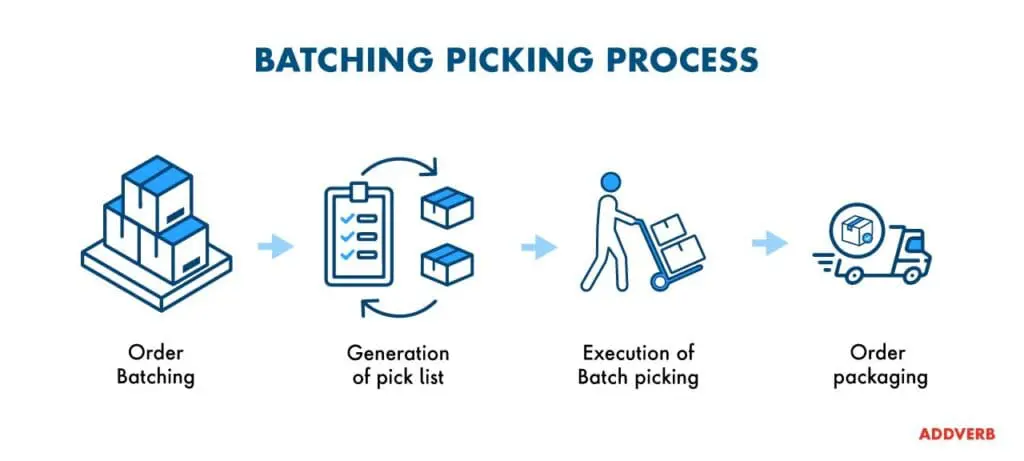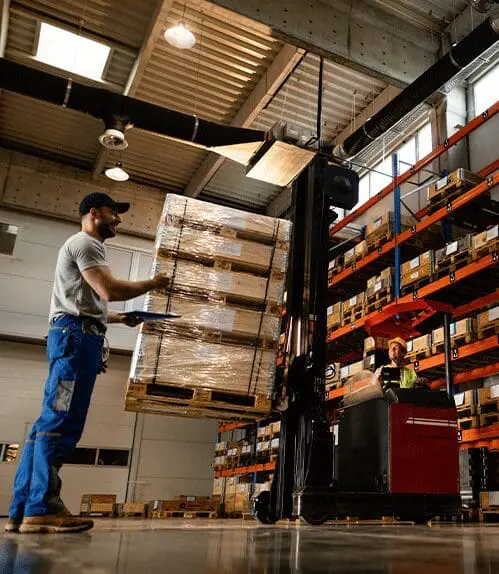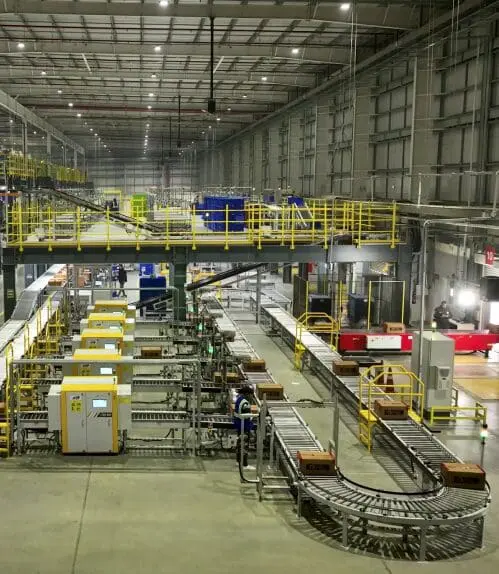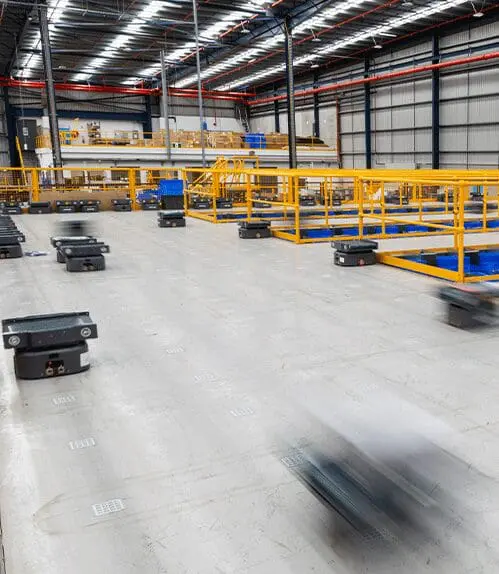Table of Contents
Order picking, often referred to as the warehouse picking process, involves selecting items from a warehouse’s inventory to fulfill customer orders.
As one of the most labor-intensive and costly functions in warehousing, it consumes 70% of total time, drives 60% of all activities, and accounts for 55% of operational costs.
To optimize, innovative businesses employ strategies that minimize the time and distance required for pickers to locate and retrieve products, thereby enhancing productivity and reducing errors. Given its significance, understanding the various types of order picking can help you optimize operations, reduce costs, and significantly boost overall efficiency.
Types of Picking in Warehouse
Discrete Picking (Single Order Picking)
In discrete picking, a picker completes one order at a time, retrieving items from designated locations using a picklist and a cart or crate. This method is straightforward but can be less efficient due to significant travel time.
Advantages:
- Simple to implement and manage
- Minimizes the risk of order errors
Challenges:
- High travel time, leading to inefficiencies
- Not ideal for high-volume operations
Cluster Picking
Veloce, our automated guided robot shuttle enables Goods to Person picking through an automatic storage and retrieval process. With a carrying capacity of 4-8 crates, it travels at a speed of 1m/s
Cluster picking consolidates multiple orders into a single picking run, focusing on retrieving items from common locations. The picker uses a multi-tier cart to hold totes or crates, each representing a different order. This method, also known as “Pick to Cart,” reduces travel time by handling multiple orders simultaneously.
Advantages:
- Efficient for fulfilling multiple orders in one trip
- Reduces picker travel time, increasing throughput
Challenges:
- Requires careful organization to avoid order mix-ups
- Less suitable for orders with a high number of SKUs
Batch Picking
Batch picking involves collecting a group of orders by picking one SKU at a time across multiple orders. This method minimizes repeated trips to the same location, making it ideal for operations with defined picking windows.

Advantages:
- Reduces travel time, increasing picking efficiency
- Ideal for handling multiple similar orders
Challenges:
- Requires coordination and accurate batch organisation
- Less flexible for orders with diverse SKUs
READ MORE: How Batch Picking Streamlines Order Fulfillment in Warehousing
Zone Picking
Zone picking divides the warehouse into zones, with each zone assigned to a specific picker. Orders are processed within these zones, with the order crate moving from zone to zone until completion. Also known as “Pick and Pass,” this method is advantageous in large warehouses with numerous SKUs.
Advantages:
- Increases picker familiarity with specific zones
- Reduces travel time within large warehouses
Challenges:
- Complex to manage and schedule, particularly during high demand
- Potential delays if an order misses its scheduled time slot
Wave Picking
Wave picking organizes orders into “waves,” which can range from a few to hundreds depending on volume and shipping schedules. The picker gathers products for multiple orders in one sweep, sorting them later in a staging area. This method is popular in environments with high SKU diversity, such as e-commerce operations.
Advantages:
- Improves accuracy with a two-stage picking process
- Efficient for handling large volumes of diverse SKUs
Challenges:
- Requires precise timing and coordination
- Potential delays if waves are not efficiently managed
Automated Picking Processes
Classification basis Picking Systems
Goods-to-Person
Addverb’s Goods-to-Person solutions revolutionize picking by automating the retrieval and delivery of SKUs. This system can reduce picking time by over 90% and significantly enhance accuracy, eliminating manual errors and streamlining the entire process.
Advantages:
- Drastically reduces time and enhances picking accuracy
- Eliminates manual consolidation errors
Person-to-Goods
Addverb’s Person-to-Goods technologies, including pick-by-voice, vision, and light systems, guide pickers to improve operational productivity. These advanced tools, coupled with Addverb’s Warehouse Control System, optimize labour by prioritizing tasks based on order urgency.
Advantages:
- Increases efficiency and accuracy in picking
- Optimizes labour allocation and task prioritization
Advantages of Automated Order Picking Systems
- Increased Efficiency: Automation streamlines the picking process, reducing the time and effort needed to locate and retrieve items, leading to faster order fulfilment.
- Reduced Labor Costs: Automation decreases reliance on manual labour, lowering costs and allowing staff to focus on more complex tasks.
- Enhanced Scalability: Automated systems can easily handle large order volumes and adapt to increased demand without significant investment in additional labour or space.
- Improved Inventory Management: Real-time tracking and reporting enhance inventory accuracy, helping prevent stockouts and overstock situations.
- Better Safety: Automation reduces the need for workers to navigate aisles, minimizing the risk of accidents and injuries associated with manual picking.
- Faster Order Processing: Optimized picking routes and reduced manual handling speed up order processing, boosting customer satisfaction.
Conclusion
The choice of order picking method depends on factors such as SKU characteristics, order profiles, resource constraints, and facility size. Each method offers distinct advantages, and integrating automated solutions can further enhance efficiency, accuracy, and overall warehouse performance.

FAQ
What is picking in a warehouse?
Order picking is the process of selecting items in a warehouse from inventory for the fulfillment of customer orders. This process is the most significant part of an order fulfillment cycle, either manual or automated. It aims to gather all selected items efficiently, pack them, and communicate them for shipping.
Many picking methods exist, including discrete, batch, and wave picking, depending on order volume types and the size of the warehouse. Streamlining the picking method increases efficiency, reduces errors, and guarantees a swifter execution of all orders.
What is the most efficient order-picking method?
The most efficient method depends on the specific warehouse operations. For high-volume environments, batch picking or automated picking often offer the best efficiency.
How does zone picking differ from wave picking?
Zone picking assigns pickers to specific areas, while wave picking organizes orders into waves, allowing for batch processing across zones based on priority.
Can order picking be fully automated?
Yes, with technologies like Automated Storage and Retrieval Systems (ASRS) and Autonomous Mobile Robots (AMRs), order picking can be fully automated, enhancing both speed and accuracy.
Why is pick-to-light popular in fast-paced environments?
Pick-to-light is popular because it reduces errors and speeds up the picking process by guiding workers with visual cues, making it ideal for fast-paced environments.
What role do AMRs play in order picking?
AMRs can be used in discrete picking for their flexibility and precision, making them suitable for low-volume, high-mix operations. They can also assist in batch and zone picking by transporting items within the warehouse.
Founded in 2016, Addverb offers complete robotics solutions for warehouse and industrial automation, with a strong global presence through its subsidiaries worldwide. The company provides a range of in-house automation products, including Autonomous Mobile Robots, ASRS, and sorting technologies. It serves over 350+ clients, including well-known companies such as Coca-Cola, Amazon, and DHL.





